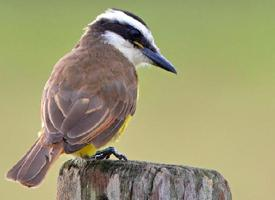
Weights and measures
| Length | 22 cm |
|---|---|
| Weight | 63 g |
State of endangerment
| Endangered |
Animal description
The Great Kiskadee (Pitangus sulphuratus) is a vibrant and boisterous bird that belongs to the tyrant flycatcher family, one of the largest families of birds. This species is easily recognizable by its robust size, loud calls, and striking coloration, making it a conspicuous presence in its habitats. The Great Kiskadee is native to a broad swathe of the Americas, from the southern United States through Central America, to South America as far south as Argentina and Uruguay.Measuring approximately 8.5 to 10.5 inches (22 to 27 cm) in length and weighing around 50 to 70 grams, the Great Kiskadee is among the larger species of flycatchers. Its plumage is a study in contrast and bright colors. The bird sports a bright yellow underbelly that extends up over its breast, sharply contrasting with its rich brown wings and back. The head is adorned with a striking black and white pattern; a bold white stripe sits above its eyes, stretching from the beak to the back of the head, bordered above by a black stripe that runs through the eyes. Its crown is a rich chestnut. The stout bill, ideal for capturing a variety of prey, is black and strong.
One of the most distinctive features of the Great Kiskadee is its loud and unmistakable call, from which it gets its name. The call, a spirited "kis-ka-dee," is a common sound in its range, echoing through open woodlands, edges of forests, riversides, and urban areas. This adaptability to various environments, including human-altered landscapes, is a testament to the bird's resilience and versatility.
Diet-wise, the Great Kiskadee is an opportunist, feeding on a wide range of items from insects and small vertebrates to fruits and berries. Its hunting technique is as versatile as its diet, catching insects in flight, plucking prey off the ground or from vegetation, and even diving into water to catch small fish.
Breeding behavior of the Great Kiskadee involves the construction of a large, bulky nest, often situated in a tree or on a man-made structure. Both parents are involved in nest building, incubating the eggs, and feeding the chicks. The nest's structure is an impressive dome shape with a side entrance, made from sticks, grass, and often lined with softer materials.
The Great Kiskadee plays a significant role in its ecosystem as both predator and prey. It helps control insect populations, while its eggs and young are targeted by various predators, including larger birds and climbing mammals. Despite these challenges, the species remains abundant and widespread, classified as Least Concern by the International Union for Conservation of Nature (IUCN), indicating a stable population.
In summary, the Great Kiskadee is a striking, adaptable, and vocal bird, thriving across a wide range of habitats in the Americas. Its colorful appearance, distinctive call, and bold behavior make it one of the most recognizable and beloved birds in its range, embodying the vibrancy and diversity of the ecosystems it inhabits.
Similar Animals
New photos of animals
Top 10 animals
- Dolphin gull (Leucophaeus scoresbii)
- Diana monkey (Cercopithecus diana)
- Moustached guenon (Cercopithecus cephus)
- Galápagos tortoise (Geochelone nigra complex)
- Stone loach (Barbatula barbatula)
- Japanese macaque (Macaca fuscata)
- Greek tortoise (Testudo graeca)
- Russian tortoise (Testudo horsfieldii)
- Common flying dragon (Draco volans)
- Galápagos penguin (Spheniscus mendiculus)

